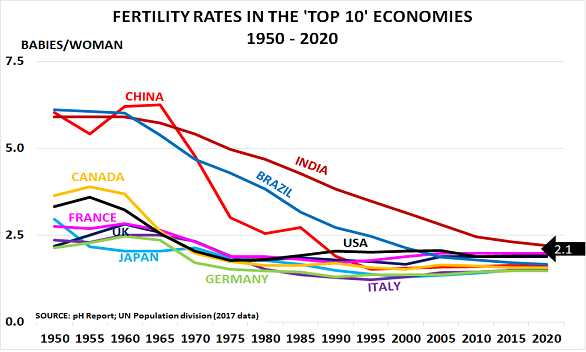Flexible Working Is Key To Reversing Today's Collapse In Fertility Rates

Women in most parts of the world are not having enough children to replace our population. This is one of the great issues of our time, but is hardly ever discussed.
Yet the issue is very topical, with Chinese births falling to a 60-year low last year. Only 15.23 million babies were born, the lowest level since 1961 when the population was 654 million, less than half today’s 1.4bn. Soon, deaths will start to overtake births – as they have already in Japan.
It used to be thought that China was a special case due to its “one child policy”, pictured above. But this law was relaxed in 2015. And although births did rise in 2016, as some couples took advantage of the new law, forecasts that births could reach 23m in 2018 have proved completely wrong.
FERTILITY RATES HAVE COLLAPSED AROUND THE WORLD

China is not alone, however, in seeing its fertility rates collapse, as the chart of the world’s 10 largest economies confirms. It shows the number of babies/woman being born since 1950, based on UN Population Division data:
- Asia. China’s rate has fallen from 6 to 1.6; India from 5.9 to 2.2; Japan from 3 to 1.5
- Americas. Brazil has fallen from 6.1 to 1.7; Canada from 3.6 to 1.6; USA from 3.3 to 1.9
- Europe. The UK has fallen from 2.2 to 1.9; Italy from 2.4 to 1.5; France from 2.8 to 2; Germanyfrom 2.1 to 1.5
So only India is now above the replacement level of 2.1 babies/woman. And probably this will change within the next 5 – 10 years as latest national data shows that 12 states are already below replacement levels, whilst urban areas are at just 1.8 babies/woman.
Of course, part of the reason is increasing life expectancy – women don’t need to have a baby every year to ensure someone is there to look after them when they grow old.
This was critical even 200 years ago, when life expectancy was just 30 years. But after the discovery of smallpox vaccination, Rising life expectancy enabled the Industrial Revolution to occur and today, life expectancy has more than doubled.
In turn, of course, today’s ageing populations are creating major headwinds for growth, as I discussed in Economic policy needs to focus on impact of the 100-year life. This is particularly critical in wealthier countries, given that the West faces a demographic deficit as population ages.,
But another key – and related – issue is the collapse in fertility rates itself.
POLICIES HAVE TO CHANGE IF FERTILITY RATES ARE TO RECOVER

It is easy to forget today that it is only within the last 100 years that men began to accept that women could play a full role in society. It was exactly a century ago, for example, that resistance to the idea of women voting began to crumble.
The catalyst for change was World War 1. With men having gone to fight, women had to be allowed to leave the home and go to work. And when the men came back, they felt unable to stop the move to allow women to vote. But this didn’t stop men enforcing marriage bars until the 1960s.
These meant that Western women would routinely lose their job when they got married, on the grounds that “it was the man’s job to earn the income, whilst the woman stayed at home with the children“. And, of course, women’s lives and ambitions were still restricted in a vast number of ways.
THE COST OF HAVING CHILDREN IS TOO HIGH FOR MANY WOMEN

Today, the collapse of fertility rates should be seen as a critical issue for society. Of course, not every woman wants to have children. But for those that do, there are at least 2 types of cost that currently discourage them.
One “cost” is simply the high cost of living. In China, for example, Caixin notes that
“High parenting costs are severely inhibiting. For example, in a typical Chinese middle-class family, the average annual cost of raising a child is about 30,000 yuan ($4,400).”
This is higher than China’s average per capita disposable income at just $4165 in 2018, according to government data.
But there is another “cost” that women have to face if they want to have children. This is that job conditions are still based on the pre-1960 pattern. As a recent survey by the UK parenting site, Mumsnet, reports:
“Three-quarters of parents found flexible working — including part-time hours, job shares and reduced hours during school holidays — more important to them than perks such as health insurance and gym membership, and more than half of them valued it over getting a pay rise.”
Tech companies seem particularly bad in this area, as one mother wrote recently about working at Facebook:
“I love my job, but I love my baby even more. When I told Facebook I wanted to work from home part-time, HR was firm: You can’t work from home, you can’t work part-time, and you can’t take extra unpaid leave…..Zuckerberg said he was sorry I was leaving.”
Most companies still operate a version of the same out-of-date policies. It’s time that they, and governments, began to wake up to the consequences. Common sense tells us that everyone would benefit from introducing more flexible working arrangements. And it is also the only way that we will get back to replacing our population, before it is too late.
Disclosure: I wrote this article myself, and it expresses my own opinions. I am not receiving compensation for it. I have no business relationship with any company whose stock is mentioned in this ...
more


